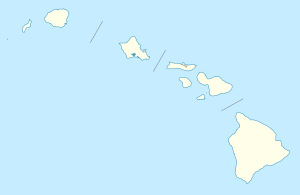Pearl Harbor National Wildlife Refuge facts for kids
Quick facts for kids Pearl Harbor National Wildlife Refuge |
|
|---|---|
|
IUCN Category IV (Habitat/Species Management Area)
|
|
| Location | Oʻahu, Hawaii, United States |
| Established | 1972 |
| Governing body | U.S. Fish and Wildlife Service |
| Website | Pearl Harbor National Wildlife Refuge |
The Pearl Harbor National Wildlife Refuge is a special protected area for wildlife. It is located on the island of Oʻahu in Hawaii. This refuge was created in 1972. Its main goal was to help wildlife that was disturbed when the Honolulu International Airport built its Reef Runway.
The refuge has three main parts, called units. These are the Honouliuli, Waiwa, and Kalaeloa Units. The United States Navy helps manage the Honouliuli and Waiawa Units. The Kalaeloa Unit was added in 2001. Working together, the U.S. Fish and Wildlife Service made this important wildlife refuge possible.
Contents
Protecting Hawaii's Nature
The Pearl Harbor National Wildlife Refuge protects many different kinds of habitats. These habitats are home to unique plants and animals. Many of these species are found only in Hawaii.
Honouliuli Unit: Freshwater Wetlands
The Honouliuli Unit has two large freshwater wetland areas. These areas are carefully managed to create a good home for various waterbirds. This includes Hawaii's endangered waterbirds and birds that migrate, or travel, long distances.
These two wetland areas have islands where birds can nest. They also have water plants and mudflats. Birds use these spots to build nests and find food all year long.
Waiawa Unit: Brackish Ponds and Birds
The Waiawa Unit has two ponds filled with brackish water. This means the water is a mix of fresh and saltwater. One of these ponds is mainly managed for the endangered aeʻo. This bird is a type of black-winged stilt.
The special environment of this pond, which is like an estuary, is perfect. It helps grow lots of food for four different endangered waterbird species that live there.
Kalaeloa Unit: Plants and Shrimp Pools
The Kalaeloa Unit used to be part of a naval air station. It was added to the refuge to protect two endangered plants. These are the ʻEwa Hinahina and the ʻAkoko. This area is made of old, raised limestone coral reef. It has the last remaining ancient coastal dry shrubland plant communities. These types of plant areas used to be common across the ʻEwa Plain.
This unit is also home to special anchialine pools. These are pools of saltwater that connect to the ocean through tiny cracks in the limestone. These pools are home to the ʻōpaeʻula, which are tiny Hawaiian shrimp.
Native coastal plants still grow well at Kalaeloa. Among them are the two endangered plant species. The largest group of ʻAkoko on Oʻahu lives here. Also, the second largest group of the endangered ʻEwa Hinahina can be found in this unit. Other native plants include the night-blooming Maiapilo. It has beautiful, sweet-smelling flowers. There is also the Hinahina, a soft, silky-looking plant. Another is Naio, which is one of the few native plants that can compete well against non-native grasses.
Visiting the Refuge
To keep these delicate habitats safe, the Pearl Harbor National Wildlife Refuge is closed to visitors.


